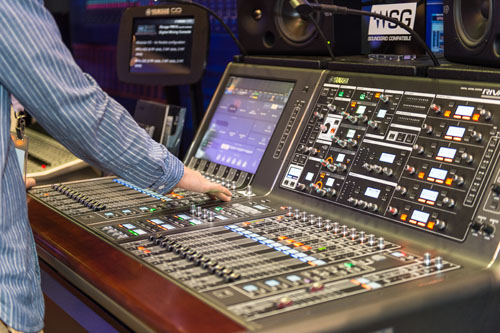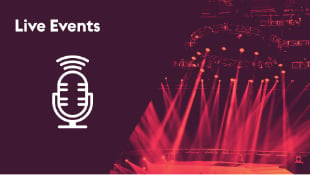Rider-Ready: Sports Venues Turn to Top-Tier Touring Sound Systems
By Dan Daley, Special to AVIXA
 Once upon a time, stadiums and arenas were used mostly for sporting events, and concerts halls were used for music — each venue had its own type of sound system design and rarely did the two meet. Sports facilities required high sound pressure level (SPL) systems tuned for speech intelligibility, while music venues focused on full-range frequency reproduction. And it largely stayed that way through when Alex Rodriguez was playing for the New York Yankees and Linkin Park was selling out Madison Square Garden.
Once upon a time, stadiums and arenas were used mostly for sporting events, and concerts halls were used for music — each venue had its own type of sound system design and rarely did the two meet. Sports facilities required high sound pressure level (SPL) systems tuned for speech intelligibility, while music venues focused on full-range frequency reproduction. And it largely stayed that way through when Alex Rodriguez was playing for the New York Yankees and Linkin Park was selling out Madison Square Garden.
Today, however, municipalities and counties are demanding that the sports venues they underwrite with bonds make those ever-higher mortgage payments faster. Meanwhile, the touring business, which has taken over from records as the music industry’s main revenue driver, is experiencing an increase in overhead costs, as stadium and arena tours require bigger production systems that drive up transportation and personnel costs. Venue owners seek to increase revenue from their facilities to positively impact their ROI, with more stadiums and arenas looking at going what’s known as “rider-friendly,” aiming to attract more music shows and other sonically sensitive touring productions.
The rider, an addendum to a contract for performing at a venue, specifies details for each production. Van Halen made it notorious in the 1980s with demands for dressing-room candy bowls filled with M&Ms (with all the brown ones removed), but the rider also includes key technical specifications.
“A sound system that meets the requirements on music-touring riders has a better chance of bringing a venue more and a wider range of touring productions,” says Dan Palmer, National Manager for installation projects at L-Acoustics, one of a handful of PA system brands, including d&b audiotechnik, Meyer Sound, and EAW, routinely found on contract riders for music venues.
Those additional events are typically bestselling touring musicians, but also include productions such as circuses, award shows and other spectacles that rely on music. “You can’t just think about music touring," Palmer explains. "That’s just part of the picture as venues are looking at to fill open dates in their calendars and increase return on investment. But they have a better chance at getting the bigger, more lucrative shows with certain sound systems.”
 The top tier of touring music artists still looks askance at an arena’s or stadium’s installed public-address (PA) system as the main sound system for a concert. But the idea is gaining traction from the edges. If a venue’s house system is among a handful of desired brands, then its secondary speakers, such as those used to fill in hard-to-reach seats, or its delay speakers, for throwing sound to the farthest seats, are easier to program and integrate with the touring system.
The top tier of touring music artists still looks askance at an arena’s or stadium’s installed public-address (PA) system as the main sound system for a concert. But the idea is gaining traction from the edges. If a venue’s house system is among a handful of desired brands, then its secondary speakers, such as those used to fill in hard-to-reach seats, or its delay speakers, for throwing sound to the farthest seats, are easier to program and integrate with the touring system.
Everett Lybolt, General Manager at sound system provider Sound Image, says that while the company’s touring clients want them to provide what they need for total coverage in every venue they will play in, “I know several difficult buildings — stadiums, mostly — that have the kinds of systems we can tie into from time to time to enhance coverage in the upper decks."
That capability, says Palmer, reduces wear and tear on the venue and its rigging steel. It's also easier on the touring system because then only its main speakers need to be flown. This benefits both parties.
“That can translate into ROI for the venue and its investment in a more expensive touring-grade installed sound system,” he says, noting that the L-Acoustics PA system in Vancouver’s Rogers Arena commands as much as $1,500 a day over and above the cost of the facility rental.
Systems Integrate at Rupp Arena
A growing number of touring artists have begun to interface with the PA system installed at the University of Kentucky's Rupp Arena in the summer of 2016. The venue is home to the school's vaunted basketball teams, as well as concerts by the Rolling Stones, Bruce Springsteen, Paul McCartney, and Garth Brooks.
“We have some fill speakers positioned in such a way as to get sound around the center-hung video scoreboard, and delay speakers that can cover the balcony overhang,” explains Bob Stoops, the arena’s Technical Services Manager.
In addition, two of the four corner hanging speaker arrays, plus the side speakers, can be lowered on chain hoists and moved to one end of the venue to create a concert configuration, leaving the other two arrays as delay speakers. “Touring artists come in here carrying their own PA and they’re going to use that PA system,” he acknowledges. “But they also recognize that we have a touring-grade system installed, as well. They know the brands. So, they’ll be fine with connecting their PA with our delay and fill speakers. And that’s a service we can charge for, so even when an event isn’t using our main PA, it’s still contributing to its ROI.”
Stoops and AV systems integrator Loud & Clear, based in nearby Cincinnati, also designed the house PA system so that it could be dismantled and redeployed — in whole or in part — to other areas of the building, such as its adjacent convention center, or onto the venue’s broad patio for outdoor concerts, which becomes another revenue-generator for the venue. In the past, those needs would have been filled by a separate system from a local rental company. Stoops says the venue can rent their PA system for those applications, in whole or in part, for less than an outside rental would cost and pass the savings on to their clients. At the same time, they're applying the rental fees to amortizing the capital cost of the system. Not surprisingly, several other sports venues have inquired about the Rupp Arena’s strategy, says Stoops.
Raising Awareness
“This is a topic that definitely needs more awareness in the industry,” says Jonathan Laney, who manages customer development for d&b audiotechnik, whose PA systems have been on tour with Coldplay and Bryan Adams and are installed in the Amsterdam ArenA and Rice Owls Football Stadium in Houston. “Having installed speakers that can cover the hard-to-hit areas of an arena is an advantage for touring shows, but they also want the same level of sound quality as they get from the touring-sound system they’re carrying. So, having a rider-friendly sound system installed makes using those installed speakers — and the venue itself — more attractive.”
Laney adds that sound quality has a direct relationship with revenue and ROI. “Fan experience and expectations are changing,” he says. “The competition between venues now for the best productions justifies the capital costs.”
Sports venues have been pressured to generate faster returns on investment. With the help of tour-grade sound, more and more of them are looking to leverage the booming music touring business to achieve that goal.





.png?sfvrsn=519c2f3c_1)